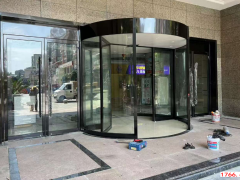The revolving door, also known as a rotary door, is a type of door that consists of several individual panels or wings that are hinged together and mounted on a central axis. This design allows the door to rotate around the axis, enabling people to enter or exit a building without the need to push or pull a traditional door.
The concept of the revolving door dates back to ancient times, with evidence of its use found in ancient Roman architecture. However, it was not until the late 19th century that the modern revolving door was patented and introduced to the public. The first known patent for a revolving door was filed by Theophilus Van Kannel in 1888, and his design became the basis for many subsequent variations of the revolving door.
One of the main advantages of the revolving door is its ability to provide a barrier against drafts and air infiltration. Unlike traditional doors, which often allow a rush of air to enter or exit a building when opened, the revolving door creates an airlock that helps to maintain a more consistent indoor climate. This feature makes revolving doors particularly popular in areas with extreme weather conditions, as they help to reduce energy consumption by minimizing heat or cool air loss.
In addition to their energy-saving benefits, revolving doors also offer improved security and safety. The continuous rotation of the door panels makes it difficult for unauthorized individuals to enter a building without being noticed, as the door is always in motion. This makes revolving doors a popular choice for high-security buildings, such as banks, government offices, and airports, where controlled access is essential.
Furthermore, revolving doors are designed to accommodate a high volume of foot traffic, making them ideal for busy entrances. The multiple panels allow for multiple people to enter or exit the building simultaneously, without causing congestion or delays. This feature is particularly advantageous in areas with heavy pedestrian traffic, such as shopping malls, hotels, and office buildings.
Another important benefit of revolving doors is their accessibility for individuals with disabilities. Unlike traditional doors, which may pose challenges for those using mobility aids, such as wheelchairs or walkers, revolving doors are designed to be easily navigable. The wide entrance and smooth rotation of the door panels allow for seamless entry and exit for individuals of all abilities.
Despite their numerous advantages, revolving doors also have some drawbacks. One of the main concerns is the potential for accidents, particularly when children or pets are involved. The rotating motion of the door can pose a risk if not used properly or if individuals attempt to pass through the door when it is already in motion. To mitigate this risk, most revolving doors are equipped with safety sensors and mechanisms that detect obstructions and automatically stop or reverse the rotation to prevent accidents.
In conclusion, the revolving door is a versatile and efficient type of entrance that offers numerous benefits. From energy savings and improved security to enhanced accessibility and efficient traffic flow, revolving doors have proven to be a valuable addition to modern architecture. While they may present certain risks if not used correctly, the safety features implemented in most revolving doors help to ensure a safe and seamless experience for users. As technology continues to advance, it is likely that revolving doors will continue to evolve and adapt to meet the changing needs of buildings and their occupants.
旋转门也称为旋转门,是一种由几个单独的面板或翼板组成的门,这些面板或翼板铰接在一起并安装在一个中心轴上。这种设计允许门绕轴旋转,使人们无需推拉传统的门就能进出建筑物。
旋转门的概念可以追溯到古代,在古罗马建筑中就有使用的证据。然而,直到19世纪晚期,现代旋转门才获得专利并被介绍给公众。第一个已知的旋转门专利是由提阿非罗·范·坎内尔在1888年申请的,他的设计成为旋转门后来许多变化的基础。
旋转门的一个主要优点是它能够提供防止气流和空气渗透的屏障。不同于传统的门,当打开时,通常允许气流进出建筑物,旋转门创造了一个气闸,有助于保持更一致的室内气候。这一特点使得旋转门在极端天气条件下特别受欢迎,因为它们有助于通过最大限度地减少热量或冷空气损失来降低能耗。
除了节能之外,旋转门还提高了安全性。门板的连续旋转使得未经授权的个人很难进入建筑物而不被注意到,因为门总是在运动。这使得旋转门成为高安全性建筑的流行选择,如银行、政府办公室和机场,在这些地方,受控进入是必不可少的。
此外,旋转门的设计可以容纳大量的人流,是繁忙入口的理想选择。多个面板允许多人同时进入或离开建筑物,而不会造成拥挤或延迟。该特征在行人流量大的区域,例如购物中心、酒店和办公楼中尤其有利。
旋转门的另一个重要好处是方便残疾人使用。传统的门可能会对使用轮椅或助行器等助行器的人造成挑战,与此不同,旋转门的设计便于通行。门面板的宽入口和平滑旋转允许各种能力的个人无缝进出。
尽管旋转门有许多优点,但它也有一些缺点。一个主要的担忧是潜在的事故,特别是当涉及到儿童或宠物的时候。如果使用不当,或者如果有人试图在门已经运动时通过门,门的旋转运动会造成危险。为了降低这种风险,大多数旋转门都配备了安全传感器和机械装置,可以检测障碍物并自动停止或反转旋转以防止事故发生。
总之,旋转门是一种多功能和高效的入口类型,提供了许多好处。从节能和提高安全性到增强可达性和提高交通流量,旋转门已被证明是现代建筑的一个有价值的补充。虽然如果使用不当,它们可能会带来一定的风险,但大多数旋转门采用的安全功能有助于确保用户获得安全、无缝的体验。随着技术的不断进步,旋转门很可能会继续发展和适应,以满足建筑物及其居住者不断变化的需求。


